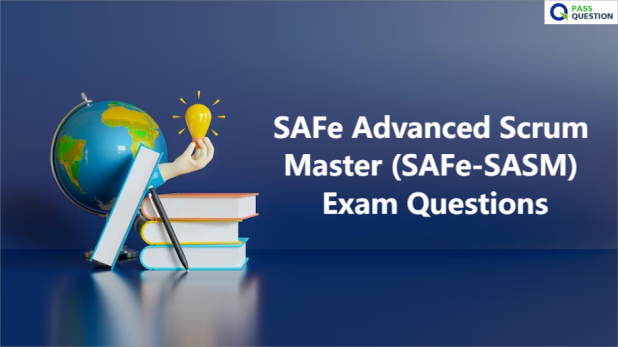SAFe Advanced Scrum Master (SAFe-SASM) Exam Questions
Preparing for the SAFe Advanced Scrum Master (SAFe-SASM) certification can be a challenging endeavor, but with the right resources, you can approach the exam with confidence. PassQuestion offers a comprehensive set of SAFe Advanced Scrum Master (SAFe-SASM) Exam Questions designed to provide you with the best preparation possible. These carefully curated questions cover essential topics and scenarios that you will encounter on the actual exam, helping you to solidify your understanding and improve your test-taking skills. Whether you are new to SAFe or an experienced Scrum Master looking to advance your knowledge, PassQuestion SAFe Advanced Scrum Master (SAFe-SASM) Exam Questions are an invaluable tool to ensure your success.

SAFe Advanced Scrum Master (SASM) Certification
The SAFe Advanced Scrum Master (SASM) Certification, provided by Scaled Agile, Inc., is a prestigious credential aimed at seasoned Scrum Masters seeking to enhance their expertise within the SAFe (Scaled Agile Framework) methodology. This advanced certification extends beyond basic Scrum principles, exploring more intricate aspects of Agile practices on a larger scale. Achieving the SASM Certification signifies a Scrum Master's dedication to their professional development and their ability to contribute to Agile initiatives at a higher organizational tier. This credential not only boosts their career opportunities but also equips them with the capabilities to drive substantial improvements within their teams and organizations.
Exam Information
Duration: 120 minutes
Number of questions: 60
Passing score: 44/60 (73%)
Competency level
Advanced; Expert, fully competent; can perform tasks with little assistance
Question format: Multiple choice (one answer) or multiple select (2-3 answers)
Delivery: Web-based, closed book, no outside assistance, timed
Languages: English
SAFe Advanced Scrum Master(SASM) Exam Topics
Exploring the Scrum Master role (15%)
- Explore Scrum Master challenges in the Enterprise
- Explain the purpose and basic constructs of SAFe
- Establish Scrum Master connections in SAFe
Applying SAFe Principles (15%)
- 1 - Take an economic view
- 2 - Apply systems thinking
- 3 - Assume variability; preserve options
- 4 - Build incrementally with fast, integrated learning cycles
- 5 - Base milestones on objective evaluation of working systems
- 6 - Visualize and limit WIP, reduce batch sizes, and manage queue lengths
- 7 - Apply cadence, synchronize with cross-domain planning
- 8 - Unlock the intrinsic motivation of knowledge workers
- 9 - Decentralize decision-making
Exploring Agile and Scrum anti-patterns (13%)
- Explore anti-patterns associated with the Product Owner role
- Explain how Stories and tasks may lead to anti-patterns
- Identify context-specific anti-patterns in your environment
Facilitating program execution (15%)
- Synchronize development with the Agile Release Train
- Organize teams on the Train
- Plan the Program Increment
- Execute the Program Increment
- Release value on demand
- Prepare for the next PI Planning session
Improving flow with Kanban and XP (13%)
- Build your Kanban board
- Measure and optimize flow
- Build quality in
- Foster engineering craftsmanship
- Facilitate collaboration with Architects, System Team, and Operations
Building high-performing teams (17%)
- Foster collaboration on the team
- Facilitate cross-team collaboration
- Build trust with stakeholders
- Develop team skill set
- Create an Improvement Backlog
Improving program performance (12%)
- Explore the Inspect and Adapt process
- Apply problem-solving workshop
View Online SAFe Advanced Scrum Master (SASM) Free Questions
1. An Agile Team decides they want to use pair programming in future Iterations. Where should this be captured?
A.In the Inspect and Adapt meeting notes
B.In the team retrospective notes
C.In the Program Backlog
D.In the team's improvement backlog
Answer: B
2. Why are phase-gate Milestones problematic?
A.They prohibit decision-making at the Large-Solution level
B.They only allow integration on PI boundaries
C.They use documentation as a proxy for Solution progress
D.They fix designs too late in the process
Answer: C
3. What are two characteristics of teams that fear conflict? (Choose two.)
A.They avoid pair work
B.They ignore controversial topics that are critical to team success
C.They fail to tap into all the opinions and perspectives of team members
D.They have longer meetings
E.They do not focus on results
Answer: B, C
4. What is one problem with phase-gate Milestones?
A.They assume a point Solution exists and can be built right the first time
B.They force design decisions too late in the process
C.They account for variability inherent in the process
D.They require the Product Owner to act as gatekeeper or guardian of the process
Answer: A
5. What are two timestamps required to measure lead time when using a Team Kanban board? (Choose two.)
A.When the Story is released to users and validated
B.When the Story is deployed
C.When the Agile Team pulls a Story onto the board
D.When the Story is accepted by the Product Owner
E.When the team completes validation of the Story
Answer: C, D
6. What is one way a Scrum Master can gain the confidence of a stakeholder?
A.Establish a daily sync meeting with the stakeholder
B.Invite the stakeholder to the Iteration retrospective
C.Make sure the results of the retrospectives are made public
D.Make the process visible
Answer: D
7. What should be the first step a team should take to feed potential problems into the Problem Solving workshop?
A.Identify enablers needed to build out the Architectural Runway
B.Conduct a short team retrospective
C.Review feedback from the System Demo
D.Analyze quantitative & qualitative metrics
Answer: D
8. Which of the SAFe Core Values enables trust across the ART?
A. Transparency
B. Adaptation
C. Built-in Quality
D. Decentralized decision-making
Answer: A
9. What is one way a Scrum Master leads the team's efforts for relentless improvement?
A.By helping teams become better problem solvers
B.By scheduling team meetings
C.By building a high-performing team
D.By focusing on technical discipline
Answer: A
10. The purpose of Continuous Integration is to deliver what?
A.Potentially deployable code
B.New builds on the test environment
C.Smaller batch sizes
D.Specific customer functionality
Answer: A
- TOP 50 Exam Questions
-
Exam
All copyrights reserved 2025 PassQuestion NETWORK CO.,LIMITED. All Rights Reserved.

